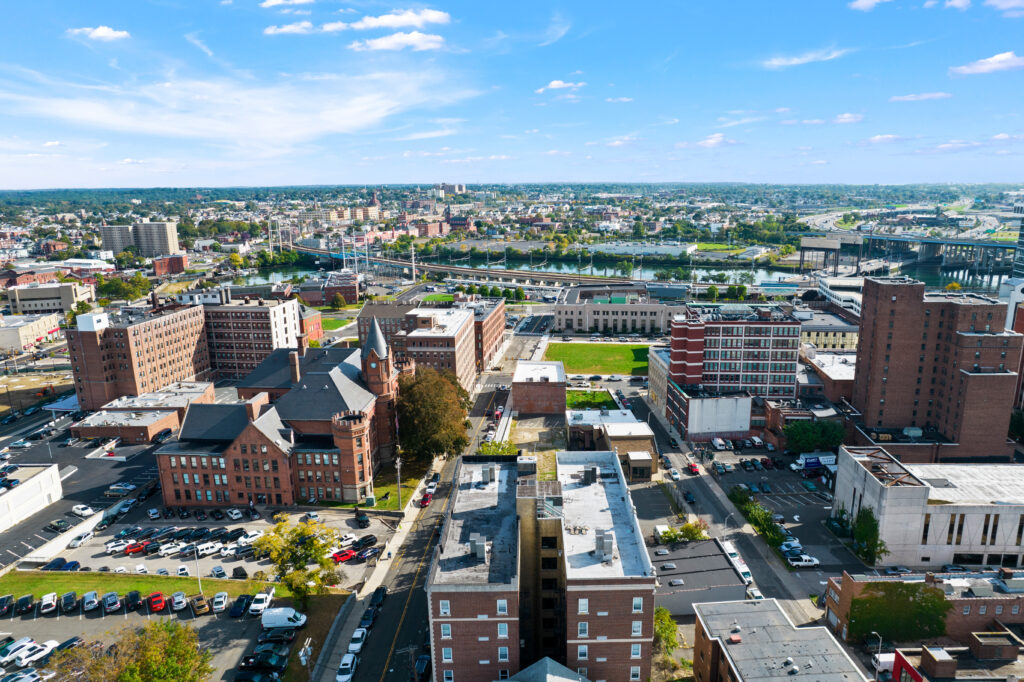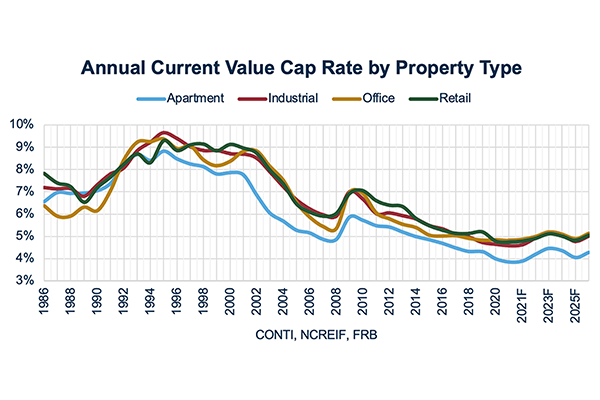
How are multifamily properties valued?
Apartment complexes are valued differently than properties in residential real estate, which is an important idea to keep in mind. Residential multifamily properties value assessment is based on comparable assets. “Comps” are surrounding residential deals that recently closed and are used to help determine the opening price of a new listing. Apartments are priced based on the potential capital they can provide an investor relative to their price point. A capitalization rate provides a simple but helpful quantitative representation. This multifamily cap rate serves as a snapshot of a multifamily deal.
Multifamily Cap rates explained
To better understand multifamily as an investor, it’s crucial to learn what cap rates entail and their application in commercial real estate. The capitalization rate, or “cap rate,” helps buyers determine how many years it will take before their deal provides a return.
According to 2nd Kitchen, “a key metric used by investors to analyze real estate investments by comparing its cap rate to similar properties. It’s the most commonly used metric for evaluating the risk and ROI [return on investment] involved in a real estate investment.”
This ratio enables investors to evaluate comparable deals, locate potentially profitable pursuits, or identify whether their ongoing investments suffer from poor management.
Using a cap rate, investors can assess individual properties’ total worth and productivity and how they stand in their submarket and community. The following are the three principal advantages of determining a multifamily property’s cap rate:
- Risk Analysis: You are responsible for identifying the ideal risk-reward ratio. The potential ROI is more considerable with a higher cap rate, but the danger is also greater. Although a lower cap rate carries less risk, it might not be a wise investment.
- Vetting your investment: When evaluating potential investments in multifamily homes, you may use a multifamily cap rate as the benchmark indicator to compare various properties.
- What is your potential return on your investment?: The most significant advantage of cap rates, in the end, is the capacity to estimate a financial return to the best of your ability using the information at hand.
Multifamily cap rates by market
Cap rates function as a standard to gauge a building’s worth. Risky investments tend to offer high cap rates. These inflated cap rates can result in a substantial reward by enabling a speedy return on investment. Relatively low-risk investments result in a reduced cap rate but presumably maintain a more consistent income and price.
Knowing how to compare cap rates and trusting your intuition alongside the numbers is critical in scoping out a multifamily deal. It may make the most sense to categorize where cap rates tend to fall by market type and asset class. According to Forbes, investors can organize cap rates in the following way:
- Low Cap Rate: (3%–5.5%) is “likely to be found in a nicer area with better amenities, lower crime rates, better school systems, newer construction and typically A- or B-class properties.”
- Medium Cap Rate: (5.5%–8%) is “usually found in a lower-income area with average amenities, slightly higher crime rates, average school systems, older construction and typically B- or C-class properties.”
- High Cap Rate: (8% or higher) is “usually found in a very low-income area with little to no amenities, high crime rates, poor school systems, outdated construction and typically C- or D-class properties.”
Historical multifamily cap rates:
It’s well-known that submarket and asset class tend to affect cap rates. However, market capitalization ratios generally fluctuate over time. The degree of this change depends on the state of the economy and commercial real estate.

Chart courtesy of Carlos Vas.
Cap rates historically tend to rise along with interest rates and during periods of economic distress such as a recession. As you can see from this figure, cap rates across the board increased by about 3% during the 2008 financial crisis. In this particular event, many people lost their homes due to subprime mortgages and, as a result, tended to turn to multifamily for housing, driving demand.
How to calculate cap rate
In commercial real estate, it’s a breeze to calculate a multifamily cap rate. The first step is to compute your property’s net operating income, also called the NOI. Evaluate your NOI by deducting all running costs from the total gross earnings of the building. Remember these formulas below:
NOI = Total Income – Expenses
After you know your NOI, the multifamily cap rate is calculated by taking the NOI and dividing it by a building’s sale price.
Cap Rate = NOI / Price
As a hypothetical example, take Northeast Apartments:
This property commands an asking price of $1,000,000. You discover from your research that the previous year’s total rents were $60,000, and the expenses were $10,000.
Using the NOI formula, you can determine a net operating income from this financial information:
NOI = Total Income – Expenses
NOI = $60,000 – $10,000
60,000 – 10,000 = 50,000
You can now calculate Northeast Apartments’ cap rate since you’ve established that its NOI is $50,000.To do that, you divide the NOI by the asking price of $1,000,000 using our formula.
Cap Rate = NOI / Price
Cap Rate = $50,000 / $1,000,000
50,000 / 1,000,000 = 0.05 X 100=5%
All done! The cap rate for Northeast Apartments comes out to 5%. In other words, twenty years must go by before buyers can recoup their investment on income alone. Appreciation of the asset does not get taken into account for this figure. Feel free to use our free tool as a guide to help determine if the investment property you’re looking at is the right fit for you!
Feel free to utilize this free tool by Omni to calculate your cap rates. Fill in the “property value” and “annual net income” fields with the price and NOI respectively.
What is a good cap rate for multifamily?
To answer this question, ponder the kind of investment you reasonably desire. Do you favor long-term growth or a high monthly cash flow? Usually, there is a trade-off involved. Most properties with high monthly cash flow do not experience significant long-term appreciation. However, most properties with substantial appreciation do not generate as much monthly cash flow. Even though it doesn’t appreciate over time, real estate with a high cap rate in the neighborhood often generates a sizable monthly cash flow. A high cap rate often produces a lot of cash flow but little increased value.
Forbes uses an example of a trailer park as an example of a high cap rate.
“These will produce massive amounts of cash flow monthly, but unfortunately will not go up much in value over time. Now, think of Beverly Hills as an example of a low cap rate. This area will not cash flow much after the very high expenses.”
However, homes in Beverly Hills tend to increase dramatically in value over the years and become coveted assets.
As a rule of thumb, multifamily cap rates tend to fall below the cap rates of other asset types such as industrial, office, and retail. These other investment classes are capable of generating much more income. Let’s compare a fast food restaurant to an apartment building as a hypothetical example.
Due to their decreased risk, multifamily complexes have one of the lowest average cap rates of any property asset category. According to 2ndkitchen, a suitable cap rate for multifamily properties is often between 4% – 10%.
Per Business Insider, the average McDonald’s generates $2.7 million in sales. A similar-sized building may house two or three tenants. If their rents are $1,500 per month, if all goes well, the gross income may come out to around $54,000. However, industrial, office, and industrial take on substantially more risk. In a worst-case multifamily investment, revenue is lower than expected due to vacancies.
Office, retail and industrial investments are always on the hook for supplies and cost of operation. Such expenses may include employees’ salaries on top of the mortgage for the building.
Of course, more significant multifamily investments are also subject to these additional costs. Still, generally speaking, multifamily assets tend to be among the safest investments, which explains their lower cap rates comparatively.
When comparing cap rates, only similar assets offer any meaningful indication of a deal’s value.
To reiterate, property type, building class, neighborhood type, geographical location, and overall economic situation, among many other factors, play an essential role in a cap rate.
What is a good cap rate? Is a 5.5% cap rate good?
Five percent might be a decent number for your situation. Still, in other investments, it might prove too extreme one way or another. A “five-cap” or higher may prove unrealistically high for a valuable A-class asset. In a neighborhood with a meager income, a multifamily building might be more lucrative.
The cap rate is an important indicator to consider when evaluating an investment because it offers some perspective on the horizon. Cap rate functions a lot like a forecasting prediction for investors. Be aware that this may vary based on the state of the economy, changes in NOI, and changes in property values, among other factors.
Gross rent multiplier formula
It’s good to know NOI does not include the mortgage payments; only regular operational expenses are included in this calculation. It is left out of the cap rate calculation to simplify things. Different real estate investors may utilize different amounts of debt. Many don’t leverage debt at all and buy properties outright with cash. Enter the gross rent multiplier.
According to Stessa.com, the gross rent multiplier formula utilizes a ratio much like a cap rate while including debt as a factor but leaves out operating expenses.
“While GRM is used to estimate rental property value based on the gross rental income generated, the capitalization rate (cap rate) calculation is used to determine what property value currently is or should be based on the net operating income (NOI) returned to an investor.” – Stessa.
According to the cap rate calculation, a property will have a more significant potential profit margin if the cap rate is higher. The GRM calculation shows that a property’s potential profitability increases as the GRM decreases.
Reversion cap rates explained
Think of the reversion cap rate as a quantitative representation of your exit strategy from your multifamily investment.
An “exit cap rate or the terminal cap rate” is another name. In other words, rather than measuring the cap rate at the beginning of the investment, it measures the cap rate at closing. After the investment’s duration, the property value gets calculated by dividing the anticipated net operating income (NOI) by the reversion cap rate as a ratio.
Per Disrupt Equity, “In particular, you’ll want to look for a reversion cap rate at a minimum 0.5% higher than the entry cap rate of the project.”
Striving for this may seem surprising because a greater cap rate is often desirable, but why does this mean the deal is better overall?
The answer, a higher cap rate afterward signifies investors on the transaction are being conservative with the end-game sale price in case the market declines in the future.
To recap, cap rates are investment tools used to help evaluate the efficacy of a deal based on the numbers of the individual building, NOT necessarily in comparison to other properties. Understanding this ratio is critical to keep in your commercial real estate toolbelt.
If you like this article, please share it!



Leave a Reply